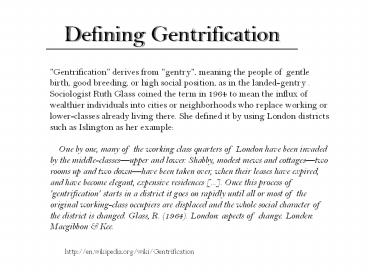Defining Gentrification PowerPoint PPT Presentation
Title: Defining Gentrification
1
Defining Gentrification
"Gentrification" derives from "gentry", meaning
the people of gentle birth, good breeding, or
high social position, as in the landed-gentry .
Sociologist Ruth Glass coined the term in 1964 to
mean the influx of wealthier individuals into
cities or neighborhoods who replace working or
lower-classes already living there. She defined
it by using London districts such as Islington as
her example One by one, many of the working
class quarters of London have been invaded by the
middle-classesupper and lower. Shabby, modest
mews and cottagestwo rooms up and two downhave
been taken over, when their leases have expired,
and have become elegant, expensive residences
.... Once this process of 'gentrification'
starts in a district it goes on rapidly until all
or most of the original working-class occupiers
are displaced and the whole social character of
the district is changed. Glass, R. (1964).
London aspects of change. Londen Macgibbon
Kee.
http//en.wikipedia.org/wiki/Gentrification
2
Indicators of Gentrification
- Leading Indicators Areas Most likely to
Experience Gentrification - High Rate of Renters
- Ease of Access to Job Centers
- High and Increasing Levels of Metropolitan
Congestion - High Architectural Value
- Comparatively Low Housing Values
Michigan State Universitys Center for Urban
Affairs Report on Gentrification in Grand Rapids
(July 2002)
3
Indicators of Gentrification
- Primary Indicators Strong Signs Gentrification
is Occurring - Move from Rental Tenure to Homeownership
- Arrival of Individuals or Households Interested
in Urban Amenities/Culture - Increase in Businesses Intended for High Income
People
4
Indicators of Gentrification
- Secondary Indicators Less Strong Signs
Gentrification is Occurring - Change in Racial Composition
- Change in Occupancy Rate
- Change in Income
- I call it erosion because that Puerto Rican
character, the Latino character in this area is
being eroded. There are huge, huge, huge areas
of Humboldt Park that are gone, that are lost to
us through gentrificationThere are a lot of
neighborhoods that have no Puerto Ricans-period,
have no people of color-period. Its a huge
impact, you know, and I think its going to get
worse before it gets better, being realistic. - Humboldt Park Resident
5
A class emerges in the post-industrial era that
values neighborhood characteristics such as
ethnic and architectural diversity.
Transformation of the labor force. Decline in
blue collar workers and a growth of white collar
workers.
New middle-class follows groups of artists and
bohemians who have moved into traditionally
ethnic low-income communities
Neighborhood begins to appeal to traditional
middle-class sensibilities and starts to loose
its original culture.
Neighborhood begins to transform to meet the
preferences of the wealthier residents.
6
- Educated young professionals, arguably attracted
to the cachet of the newly hip neighborhood in
increasing numbers, leading to a dramatic
escalation of home values and rentsIndeed,
before more eyes Wicker Park unfolded as a
serendipitous site containing to greater or
lesser degrees a host of economic and cultural
trends. - -Richard Lloyd, Neo-Bohemia
7
Supply-Side Analysis of Gentrification and the
Rent-Gap
To explain gentrification according to the
gentrifiers actions alone, while ignoring the
role of builders, developers, landlords, mortgage
lenders, government agencies, real estate agents
and tenants is excessively narrow. A. Smith
(1989) Gentrification and the spatial
constitution of the State, Antipode 21232-60.
Gap forms between capitalized ground rent and
potential ground rent in the properties highest
and best use.
Movement toward suburbs leaves areas of
disinvestment in the inner-city.
Land values decline from center out (19th century)
Mortgage lenders, developers, and entrepreneurs
begin to reinvest in inner-city.
People follow capital back to the city.
8
- PROS
- Redevelopment or renovation of housing stock
- Revitalization of the tax base
- Increased homeownership rates
- Economic opportunities
- De-concentration of poverty
- Historic preservation
- CONS
- Displacement of lower income residents
- Lack of affordable housing
- Decrease in multi-family rental units
- Loss of diversity in neighborhood businesses and
residents - Conversion of residential units to commercial
property - Decrease in social services for lower-income
residents
9
People cant afford the housing thats being
built, and the housing is not meant for them. The
housing is meant for people who have higher
incomes, most of whom are white... not all of
them, but most of them. West Town Resident
10
How You Can Help
- Southside Together Organizing for Power (STOP)
- 813 E. 63rd Street 2nd Floor Chicago, IL 60637
- 773.753.9674 stopgentrification_at_gmail.com
- Pilsen Alliance
- Alejandra Ibanez, Executive Director,
312-243-5440 - alibanez_at_sbcglobal.net www.neiu.edu/casaaztl/P
rograms.htm - Poor People's Economic Human Rights Campaign
- C/O KWRU PO Box 50678 Philadelphia, PA 19132
- march hotline 888.233.1948 info_at_economichumanr
ights.org - The Coalition to Protect Public Housing
- 984 N Hudson St. Chicago, IL 60610
- 312.280.2298 jdpfleck_at_yahoo.com

